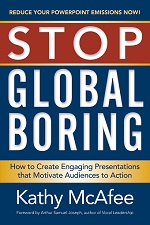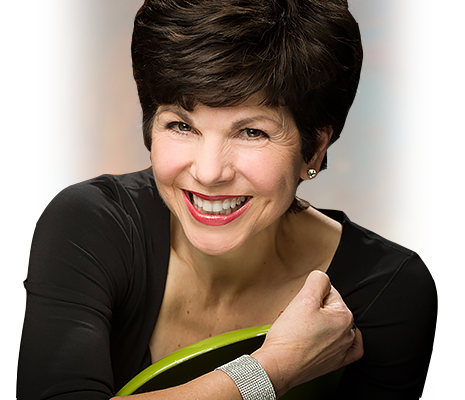
I just finished a series of one-on-one presentation coaching sessions with senior leaders at a technology company. All eight leaders attended my signature program, The Motivated Presenter, where they learned how to reduce their dependence on PowerPoint slides in order to better communicate and engage with their audience. The President of the company was very frustrated with many of the internal meetings and presentations that he had attended. He complained to me that his people often bored him with endless PowerPoint slides. He referred to these types of boring presentations as “read-a-thons.”
In my fifteen years of doing this work with clients from all disciplines and industry sectors, I have discovered the root cause of this problem: failing to plan properly. Most professionals unconsciously practice a “copy-paste preparation”approach when creating a new presentation. That is, they open the PowerPoint slide presentation that they used the last time, copy it, and save it to a new file name. Then they add more slides. This often results in slide proliferation, wasted time and money, and increased risk of failure and disappointment from the presentation.
The solution? Go analog. Don’t use PowerPoint software to plan your presentation. Discipline yourself to THINK before you build slides. I recommend that you always start planning your next presentation with a clean sheet of paper. And I have a cool tool for that…


Clean Sheet Thinking™ is a brilliantly simple presentation planning tool that guides you through the key steps in planning a high engagement presentation. Clean Sheet Thinking™ is based on the basic principle that you should start with a clean sheet of paper for every presentation because every audience is unique. It takes about thirty minutes to complete and can save you hours of time and increase the impact of your presentation. Clean Sheet Thinking™ methodology and tools can be used to plan for formal presentations, informal fire-side chats and even meetings.
Download the Clean Sheet Thinking tool to plan your next presentation. It’s available in a PDF writable format for easy keyboarding.
What is Clean Sheet Thinking?
Clean Sheet Thinking is essentially a clean sheet of paper with a few key questions added to guide you through the thinking process. It serves as a map allowing you to plot out the best course to get you where you want to go in your presentation. Rather than just driving aimlessly (at the expense of your company and your audience), Clean Sheet Thinking allows you to see the big picture, with all major and minor roads shown, the typography, the distances, the major structures, what’s connected to what, etc. Unlike a GPS (Global Positioning System) for navigation that tells you exactly how to get there (theoretically the best way, but personal experience reveals that is not always the case), Clean Sheet Thinking allows you to plot the course that you desire to take. This is when your presentation skills start to shine.
“This morning, I had a quick talk planned (informal, fire side chat type) with seven people in my organization. I used the Clean Sheet Thinking template and it got my thoughts clear. It made me think more carefully of my objective and what my audience could get out of the talk. I do many of these types of informal presentations and in the past would have given less thought and relied more on winging it – a pitfall that many presenters often face. I now have a great tool that can help me be more successful in both formal and informal presentation settings.”– Philip Slominski, Vice President, Freedom 55 Financial, London Life, Montreal, Canada
Why it works
The brilliance of Clean Sheet Thinking lies in its simplicity. Once you get used to it as a business tool, it will become second nature like brushing your teeth in the morning – something you can’t do without. By practicing this easy methodology when planning your presentations and meetings, many people find that their stress levels reduce and their focus increases. This is how we bring out the very best of our ability, by slowing down and engaging our brains early on in the planning process.
How it works – 6 simple steps
Like all great inventions, the complexity of the process is masked by the ease of use. Most of us don’t care to know how it works, just that it works and works well for us! But for the sake of full disclosure, let’s go through the six simple steps of Clean Sheet Thinking™.
- Logistics. Clean Sheet Thinking starts with the easy-to-answer logistical questions: what, who, when, where – how long: the things that help you show up at the right place at the right time to deliver the presentation. Don’t overlook this basic information and don’t leave it to someone else to tell you where you need to be and when. Your reputation and credibility could be at stake. Take charge of this vital information.
- Objectives. It then asks you to consider your objectives – the specific reasons for giving this presentation. The more explicit and measurable you are in your presentation objective setting, the more likely you are to achieve your goals. Now consider the objectives or goals of your audience. Why are they there? What do they hope to get out of this presentation? Putting yourself in the shoes of your audience members will give you a new perspective on what this presentation must achieve.
- Audience. What else do you know about your audience? Who specifically will be there? What are their passions, interests and even pet peeves? I recommend that you get specific down to the key people’s names and a bit of info about them. Use the Internet to do your research (Google, LinkedIn.com, etc.) Call people you know who know them and get additional insight. Call key members of the audience directly and find out from the horse’s mouth. Get to know your audience even before you even show up to give the presentation. This will give you a great advantage, a real leg up!
Think / Feel / Do. What responses do you want from your audience? Don’t leave it to random chance, but plan for it. Think/Feel/Do forces you to consider the three areas of response possible: intellectual activity, emotional response and physical action. When planning for your next presentation, give careful consideration to these three areas of possible response. It will help you to create impact with your presentation.
Demonstration. If you want to get your message across, demonstrating it will always be more powerful than just saying it. “Show me, don’t tell me.” Why is this? Because most people are visually dominant and believe it when they see it. When demonstrating things during your presentations, you’ll want to tap into your creativity. This is where you can have a lot of fun and truly engage your audience. Practice and rehearsal is recommended, so that your demonstration really lives up and has the full power and effect on your audience. - Key Message. Your key message is the core essence of your presentation. It’s what you want them to remember after they leave your presentation and ten years from now. Think of your key message as the central nervous system of your presentation – it drives everything else. It only makes sense to spend quality time developing, refining and delivering it for a powerful, lasting impact on your audience.
Where can you find the Clean Sheet Thinking template?
 Learn more about Clean Sheet Thinking. And download a complimentary copy of this valuable tool in a writable PDF file format – Clean Sheet Thinking – writable PDF form. If you prefer to work with a MS Word file format, you can download an earlier version of Clean Sheet Thinking-pre planning tool for presentations
Learn more about Clean Sheet Thinking. And download a complimentary copy of this valuable tool in a writable PDF file format – Clean Sheet Thinking – writable PDF form. If you prefer to work with a MS Word file format, you can download an earlier version of Clean Sheet Thinking-pre planning tool for presentations- Get my book, Stop Global Boring, which includes twelve presentation tools to help you plan, design and deliver high-engagement presentations.
- Invite me to your organization to facilitate my signature program, The Motivated Presenter. Available in half-day seminar, full day mastery class, two-day transformation intensive workshop, one-on-one presentation coaching, and team presentation coaching services. Download the At a Glance – The Motivated Presenter program with Kathy McAfee
Remember to use the Clean Sheet Thinking™ tool every time you plan a presentation, even if you’ve given it 100 times before. It’s a discipline that will make you not only a stronger presenter, but a better business leader. Think before you build!
“Kathy is really the best presentation presenter I’ve seen in my career. I’ll be using her Clean Sheet Thinking tool to plan all of my future presentations. It’s brilliantly simple and extremely useful.” – Bob Litchy, Director of Sales, MMA
Here’s to your presentation success!
For more presentation tips and insights, visit Kathy’s YouTube channel or call Kathy to discuss presentation coaching or training at (860) 371-8801 or email Kathy@AmericasMarketingMotivator.com
Note: Clean Sheet Thinking is the intellectual property of Kathy McAfee, America’s Marketing Motivator, President of Kmc Brand Innovation, LLC.

